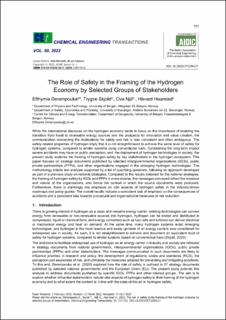| dc.contributor.author | Derempouka, Efthymia | |
| dc.contributor.author | Skjold, Trygve | |
| dc.contributor.author | Njå, Ove | |
| dc.contributor.author | Haarstad, Håvard | |
| dc.date.accessioned | 2023-01-13T15:02:36Z | |
| dc.date.available | 2023-01-13T15:02:36Z | |
| dc.date.created | 2022-09-08T10:02:53Z | |
| dc.date.issued | 2022 | |
| dc.identifier.issn | 1974-9791 | |
| dc.identifier.uri | https://hdl.handle.net/11250/3043462 | |
| dc.description.abstract | While the international discourse on the hydrogen economy tends to focus on the importance of enabling the transition from fossil to renewable energy sources and the prospects for innovation and value creation, the communication concerning the implications for safety and risk is less consistent and often ambiguous. The safety-related properties of hydrogen imply that it is not straightforward to achieve the same level of safety for hydrogen systems, compared to similar systems using conventional fuels. Considering the long-term impact severe accidents may have on public perception, and the deployment of hydrogen technologies in society, the present study explores the framing of hydrogen safety by key stakeholders in the hydrogen ecosystem. This paper focuses on strategy documents published by selected intergovernmental organisations (IGOs), public private partnerships (PPPs), and other organisations engaged in the emerging hydrogen technologies. The methodology entails text analysis supported by a list of qualifying questions, following an approach developed as part of a previous study on national strategies. Compared to the results obtained for the national strategies, the framing of hydrogen safety by IGOs and PPPs is more diverse: the messages conveyed reflect the missions and visions of the organisations, and hence the context in which the source documents were produced. Furthermore, there is alarmingly low emphasis on vital aspects of hydrogen safety in the industry-driven roadmaps and policy guides. The overall results indicate a consistent lack of emphasis on the consequences of accidents and a persistent bias towards procedural and organisational measures of risk reduction. | en_US |
| dc.language.iso | eng | en_US |
| dc.publisher | The Italian Association of Chemical Engineering | en_US |
| dc.title | The Role of Safety in the Framing of the Hydrogen Economy by Selected Groups of Stakeholders | en_US |
| dc.type | Journal article | en_US |
| dc.type | Peer reviewed | en_US |
| dc.description.version | publishedVersion | en_US |
| dc.rights.holder | Copyright 2022 The Italian Association of Chemical Engineering | en_US |
| cristin.ispublished | true | |
| cristin.fulltext | original | |
| cristin.qualitycode | 1 | |
| dc.identifier.doi | 10.3303/CET2290127 | |
| dc.identifier.cristin | 2049792 | |
| dc.source.journal | Chemical Engineering Transactions | en_US |
| dc.source.pagenumber | 757-762 | en_US |
| dc.identifier.citation | Chemical Engineering Transactions. 2022, 90, 757-762. | en_US |
| dc.source.volume | 90 | en_US |
